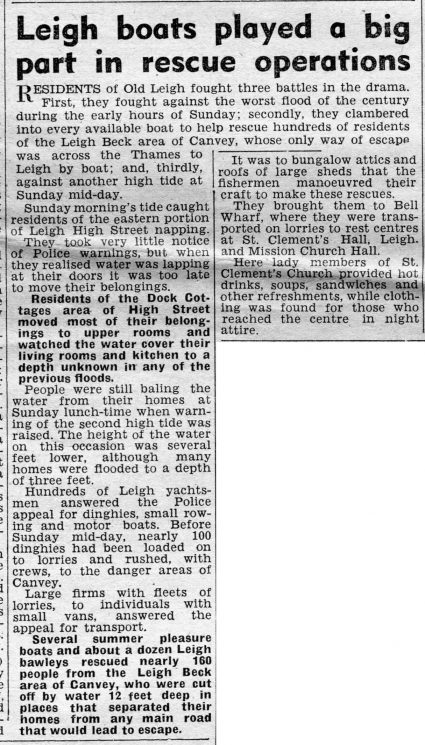Leigh boats played a big part in rescue operations

Residence of Old Leigh fought three battles in the drama.
First, they fought against the worst flood of the century during the early hours of Sunday; secondly, they clambered into every available boat to help rescue hundreds of residents of the Leigh Beck area of Canvey, whose only way of escape was across the Thames to Leigh by boat; and, thirdly, against another high tide at Sunday mid-day.
Sunday morning’s tide caught residents of the eastern portion of Leigh High Street napping. They took very little notice of Police warnings, but when they realised water was lapping at their doors it was too late to move their belongings. Residents of the Dock Cottages area of High Street moved most of their belongings to upper rooms and watched the water cover their living rooms and kitchen to a depth unknown in any of the previous floods. People were still baling the water from their homes at Sunday lunch-time when warning of the second high tide was raised. The height of the water on this occasion was several feet lower, although many homes were flooded to a depth of three feet.
Hundreds of Leigh yachtsmen answered the Police appeal for dinghies, small rowing and motor boats. Before Sunday mid-day, nearly 100 dinghies had been loaded on to lorries and rushed, with crews, to the danger areas of Canvey. Large firms with fleets of lorries, to individuals with small vans, answered the appeal for transport. Several summer pleasure boats and about a dozen Leigh bawleys rescued nearly 160 people from the Leigh Beck area of Canvey, who were cut off by water 12 feet deep in places that separated their homes from any main road that would lead to escape. It was to bungalow attics and roofs of large sheds that the fishermen manoeuvred their craft to make these rescues.
They brought them to Bell Wharf, where they were transported on lorries to rest centres at St. Clement’s Hall, Leigh, and Mission Church Hall. Here lady members of St. Clement’s Church provided hot drinks, soups, sandwiches and other refreshments, while clothing was found for those who reached the centre in night attire.




Comments about this page
Goodness, this article takes me back to one of my earliest ever memories (aged three). Our family lived at a house called Fernhurst in Norton Avenue and which was the last house in the road next to the sea wall. I recall the flood water coming through the door and up through the floorboards. We were all led up a ladder to the loft which had a side window and I clearly remember my mum, (my dad was in the RAF and away from home) my nan and us three children climbing out onto a fishing boat that had come to help the islanders. Like others, we were taken off to Leigh on Sea and then to stay with my aunt in Southend while my grandad dried out the old house in which I continued to live until I was 5 years old. On a rare visit back to Canvey about 15 years ago I discovered that the old house with a large garden (and an allotment area whereby my grandad dedicated a small patch for us kids to grow our own raspberries etc.) had disappeared a long time ago and there are now several houses in the plot. But that must be true of so many of the old style veranda properties. I remember my childhood days there very fondly!
While writing it prompted the memory of a neighbours name – Mrs Thorneycroft, who lived about three houses up the road and who was a playground assistant at Furtherwick school when I was in the first year.
Add a comment about this page